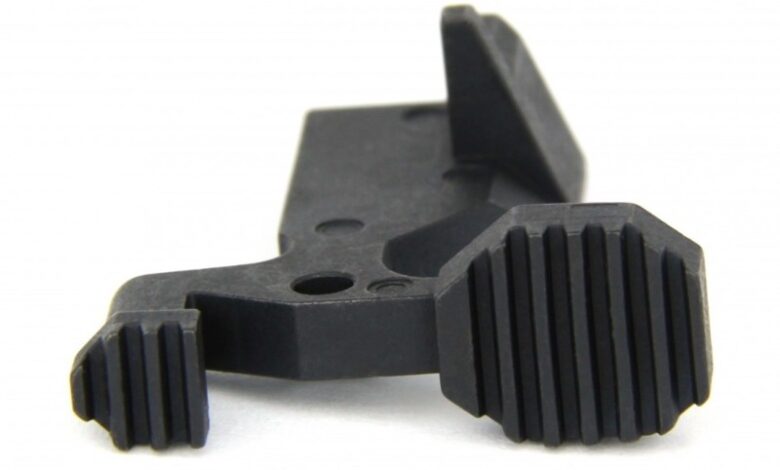The Essential Guide to AR Bolt Catches: Everything You Need to Know

Key Takeaways:
- AR bolt catches are critical for firearm safety and functionality
- They hold the bolt open to indicate the firearm is empty
- Bolt catches enhance safety by preventing accidental discharges
- They help prevent malfunctions and ensure proper feeding
- AR bolt catches impact weapon functionality, reloading, and manipulation
- Types of AR bolt catches include mil-spec, ambidextrous, and extended
- Each type has its own pros, cons, and compatibility considerations
- Proper installation and maintenance of AR bolt catches are important
- Regular cleaning, inspection, and lubrication are necessary for maintenance
- Common issues with bolt catches can be resolved through troubleshooting
- Upgrading bolt catches can improve functionality, ergonomics, and customization
- Extended and ambidextrous options offer enhanced ease of use and accessibility
- Aftermarket bolt catches should be researched for compatibility and reliability
- Installation of aftermarket bolt catches may require basic firearm assembly skills
- Compatibility with specific firearm models should be verified
- Improving AR bolt catches enhances safety, functionality, and shooting experience
- Prioritize firearm safety, proper handling, and seek professional assistance when needed
1. The Importance of AR Bolt Catches
AR bolt catch is a critical component of the AR platform, playing a crucial role in firearm safety and weapon functionality. Understanding their significance is essential for any gun owner or enthusiast. In this section, we will explore why you should care about AR bolt catches, their role in firearm safety, and how they impact the overall functionality of your weapon.
Why You Should Care About AR Bolt Catches
AR bolt catches may seem like a small and insignificant part of the firearm, but they serve a vital purpose. These components are responsible for holding the bolt open after the last round is fired, indicating that the firearm is empty. This feature is particularly important for semi-automatic rifles like the AR-15, as it ensures safe handling and prevents accidental discharges.
By caring about AR bolt catches, you demonstrate a commitment to firearm safety and responsible gun ownership. Familiarizing yourself with these components allows you to understand their proper functioning and identify any issues that may arise.
The Role of AR Bolt Catches in Firearm Safety
Firearm safety should always be a top priority for gun owners. AR bolt catches play a crucial role in enhancing safety features in firearms. When the bolt catch engages and locks the bolt open, it provides a visual and tactile indication that the firearm is empty and cannot be fired. This allows shooters to safely perform actions such as reloading or clearing malfunctions without accidentally firing a live round.
Additionally, the bolt catch serves as a mechanical interface between the magazine and the bolt carrier group, ensuring proper alignment during the feeding process. This helps prevent malfunctions, such as failures to feed or double feeds, which can be hazardous if they occur during crucial moments.
Understanding the function and importance of AR bolt catches empowers gun owners to handle their firearms safely and effectively, reducing the risk of accidents and injuries.
How AR Bolt Catches Impact Weapon Functionality
AR bolt catches not only contribute to firearm safety but also play a significant role in the overall functionality of the weapon. These components affect various aspects, including the reloading process, weapon manipulation, and the ability to quickly diagnose malfunctions.
During the reloading process, the bolt catch holds the bolt open, allowing easy access to the magazine well for inserting a fresh magazine. This feature enables faster reloads and is especially advantageous in competitive shooting or self-defense situations where every second counts.
When it comes to weapon manipulation, the bolt catch serves as a convenient control point for manipulating the bolt carrier group. It allows shooters to manually lock the bolt back for administrative functions such as chamber checks, performing immediate action drills, or diagnosing malfunctions.
In summary, AR bolt catches have a direct impact on the overall functionality and usability of your AR platform firearm, making it essential to choose the right type and maintain it properly.
2. Types of AR Bolt Catches
AR bolt catches come in different designs, each with its own set of advantages and disadvantages. Understanding the various types of AR bolt catches available on the market will help you make an informed decision when choosing the right one for your needs.
Exploring Different AR Bolt Catch Designs
One of the most common types of AR bolt catch designs is the mil-spec bolt catch. This type features a simple and durable design that is compatible with most AR-15 rifles. Another popular variant is the ambidextrous bolt catch, which allows for easier manipulation of the bolt catch from either side of the firearm, accommodating left-handed shooters or those who prefer ambidextrous controls.
Some aftermarket manufacturers offer extended bolt catches, which provide a larger surface area for easier access and improved ergonomics. These extended bolt catches are often used by competitive shooters who prioritize speed and efficiency in manipulating the firearm.
Understanding the Pros and Cons of each AR Bolt Catch Type
Each type of AR bolt catch has its own set of advantages and disadvantages. The mil-spec bolt catch is widely available, affordable, and reliable. However, it may not offer the same level of ergonomics and ease of use as some of the aftermarket options.
Ambidextrous bolt catches, on the other hand, provide enhanced accessibility for left-handed shooters and allow for more natural manipulation of the bolt catch. However, they may be more expensive and require fitting and installation by a professional gunsmith.
Extended bolt catches offer improved ergonomics and ease of use, especially in high-speed scenarios. However, they may be more prone to accidental engagements and may not be compatible with all AR-15 models or aftermarket accessories.
Choosing the Right AR Bolt Catch for Your Needs
Choosing the right AR bolt catch ultimately depends on your specific needs and preferences. Consider factors such as your shooting style, intended use of the firearm, and whether ambidextrous controls are important to you.
If you are a left-handed shooter or prefer ambidextrous controls, an ambidextrous bolt catch would be a suitable choice. If you prioritize speed in manipulation or engage in competitive shooting, an extended bolt catch may be worth considering. For general use and compatibility, a reliable mil-spec bolt catch would be a safe and practical option.
It’s important to research and consult with experts or experienced shooters to ensure the compatibility and reliability of the chosen AR bolt catch with your firearm.
3. How to Install and Maintain AR Bolt Catches
Proper installation and maintenance of AR bolt catches are crucial for optimal performance and longevity. In this section, we will provide a step-by-step guide to installing an AR bolt catch, offer tips for proper maintenance, and address common issues and troubleshooting methods.
Step-by-Step Guide to Installing an AR Bolt Catch
Installing an AR bolt catch requires basic knowledge of firearm assembly and disassembly. Here is a step-by-step guide to help you through the process:
- Ensure the firearm is unloaded and the chamber is clear.
- Remove the upper receiver from the lower receiver.
- Remove the buffer and buffer spring from the lower receiver.
- Drift out the existing roll pin that secures the current bolt catch in place.
- Remove the old bolt catch and replace it with the new one.
- Insert and secure the roll pin to hold the new bolt catch in place.
- Reassemble the lower receiver, including the buffer and buffer spring.
- Attach the upper receiver to the lower receiver.
- Perform a function check to ensure the bolt catch operates correctly.
It’s essential to follow the manufacturer’s instructions and consult with experts if you encounter any difficulties during the installation process.
Tips for Properly Maintaining Your AR Bolt Catch
Maintaining your AR bolt catch is relatively straightforward and requires regular cleaning and inspection. Here are some tips to keep your AR bolt catch in optimal condition:
- Regularly clean the bolt catch using an appropriate solvent and lubricate it with a high-quality firearm lubricant.
- Inspect the bolt catch for any signs of damage, wear, or corrosion. Replace any damaged or worn-out parts immediately.
- Check the roll pin for tightness periodically and ensure it is properly secured in place.
- Follow the manufacturer’s guidelines for maintenance and lubrication intervals.
By incorporating these maintenance practices into your firearm care routine, you can ensure the reliability and longevity of your AR bolt catch.
Common Issues and Troubleshooting with AR Bolt Catches
While AR bolt catches are generally reliable, there are some common issues that may arise. Understanding these issues and troubleshooting methods can save you time and frustration. Here are a few common problems and their solutions:
Failure to lock back: If your bolt catch fails to lock back after firing the last round, it may be due to weak magazine springs or an improperly installed or worn-out bolt catch. Check the magazine springs and consider replacing them if necessary. Inspect the bolt catch for wear or damage and replace if needed.
Accidental engagements: Extended or oversized bolt catches may be more prone to accidental engagements. If you find yourself inadvertently activating the bolt catch during shooting, consider switching to a standard or mil-spec bolt catch.
Bolt catch not engaging: If the bolt catch does not engage when the last round is fired, there may be an issue with the ammunition or the magazine. Ensure you are using high-quality ammunition and magazines that properly feed into the firearm. Clean and inspect the bolt catch for any obstructions or debris that may prevent proper engagement.
Should you encounter persistent issues or require further assistance, it is recommended to seek guidance from a professional gunsmith or manufacturer.
4. Upgrading Your AR Bolt Catch: What You Need to Know
Upgrading your AR bolt catch can be an excellent way to improve the functionality and ergonomics of your firearm. In this section, we will explore the reasons to consider upgrading your AR bolt catch, discuss aftermarket options available, and address installation and compatibility considerations.
Reasons to Upgrade Your AR Bolt Catch
There are several compelling reasons to upgrade your AR bolt catch:
Ease of use: Upgrading to an extended or ambidextrous bolt catch can make weapon manipulation and reloading more efficient, especially in high-pressure or competitive shooting scenarios.
Customization: Upgrading your bolt catch allows you to personalize your firearm according to your preferences and shooting style.
Improved ergonomics: Some aftermarket bolt catches feature enhanced design elements that provide a more comfortable and ergonomic user experience.
If any of these factors resonate with your shooting needs or preferences, upgrading your AR bolt catch may be worth considering.
Exploring Aftermarket AR Bolt Catch Options
When it comes to aftermarket AR bolt catches, you have a wide range of options to choose from. Extended bolt catches offer an enlarged surface area, making it easier to engage and manipulate the bolt catch quickly. Ambidextrous bolt catches provide increased accessibility for left-handed shooters or individuals who prefer ambidextrous controls.
There are also specialized bolt catches available for specific shooting disciplines, such as competition shooting or tactical applications. These aftermarket options may incorporate unique features, such as improved grip texture or extended paddles, to enhance performance in specific scenarios.
It is crucial to research and select a reputable manufacturer when considering aftermarket bolt catches. Look for customer reviews, seek advice from experienced shooters, and ensure compatibility with your firearm model.
Installation and Compatibility Considerations for Upgrading AR Bolt Catches
Upgrading your AR bolt catch typically requires basic firearm assembly and disassembly skills. The exact installation process may vary depending on the specific aftermarket bolt catch you choose. It is essential to carefully follow the manufacturer’s instructions provided with the product.
Compatibility is another crucial consideration when upgrading your AR bolt catch. While many aftermarket bolt catches are designed to be compatible with mil-spec AR-15 rifles, it is always prudent to verify compatibility with your specific firearm model. Some aftermarket options may require minor modifications or fitting by a professional gunsmith to ensure a proper and secure fit.
It is recommended to consult with experts or reach out to the manufacturer directly if you have any questions regarding the installation or compatibility of an aftermarket AR bolt catch.
By understanding the importance of AR bolt catches, exploring the different types available, learning how to install and maintain them, and considering the possibility of upgrading, you can enhance the safety, functionality, and overall shooting experience with your AR platform firearm. Remember to always prioritize proper firearm handling, follow safety protocols, and seek professional assistance when needed.
FAQ
Question: What is the purpose of AR bolt catches? – AR bolt catches hold the bolt open to indicate that the firearm is empty and enhance safety by preventing accidental discharges.
Question: How do AR bolt catches impact weapon functionality? – AR bolt catches affect various aspects of weapon functionality, including the reloading process, weapon manipulation, and the ability to quickly diagnose malfunctions.
Question: What are the different types of AR bolt catches? – The different types of AR bolt catches include mil-spec, ambidextrous, and extended bolt catches.
Question: What are the pros and cons of each type of AR bolt catch? – Mil-spec bolt catches are widely available and reliable, while ambidextrous bolt catches provide enhanced accessibility. Extended bolt catches offer improved ergonomics but may be prone to accidental engagements and may not be compatible with all AR-15 models or aftermarket accessories.
Question: How do I choose the right AR bolt catch for my needs? – The right AR bolt catch depends on factors such as shooting style, intended use of the firearm, and the importance of ambidextrous controls. Research and consultation with experts are essential to ensure compatibility and reliability.
Question: How do I install an AR bolt catch? – Installing an AR bolt catch requires basic firearm assembly skills. It involves removing the existing bolt catch and replacing it with the new one, following the manufacturer’s instructions.
Question: How do I properly maintain my AR bolt catch? – Regular cleaning, inspection, and lubrication are necessary for maintaining an AR bolt catch. It is important to check for any signs of damage, wear, or corrosion and replace any damaged or worn-out parts immediately.
Question: What are some common issues and troubleshooting methods for AR bolt catches? – Common issues include failure to lock back, accidental engagements, and bolt catch not engaging. Troubleshooting methods include checking magazine springs, switching to standard or mil-spec bolt catches, and ensuring high-quality ammunition and magazines are used.



